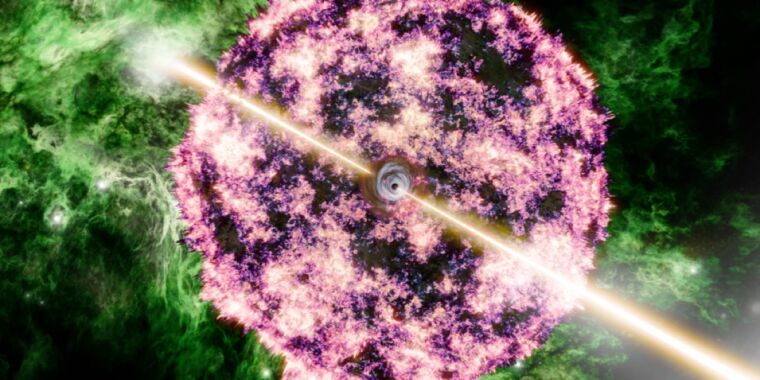Scientific Insight into the Brightest Gamma-Ray Burst of All Time
In October 2022, a profound gamma-ray burst, referred to as BOAT (Brightest Of All Time), was detected by space-based instruments. Recently published in the prestigious journal Nature Astronomy, a study confirmed that this burst originated from a supernova explosion. However, intriguingly, the expected heavy elements such as platinum and gold were notably absent, raising questions about the genesis of these elements in the cosmos.
Understanding Gamma-Ray Bursts
Gamma-ray bursts, characterized by their extraordinary energy levels, occur in distant galaxies and can persist from mere milliseconds to several hours. These bursts are categorized into two groups: long bursts, which last for more than two seconds and are often associated with galaxies undergoing rapid star formation, and short bursts, lasting less than two seconds, which originate from regions with minimal star formation.
Long bursts are believed to stem from the deaths of massive stars collapsing to form neutron stars, black holes, or magnetars. Short bursts, on the other hand, are thought to result from mergers involving neutron stars or interactions between neutron stars and black holes, forming a phenomenon known as a kilonova.
The Enigmatic GRB 221009A
The gamma-ray burst recorded in October 2022, named GRB 221009A, belonged to the long-duration category, lasting over 300 seconds. This event was detected by multiple instruments including NASA’s Fermi Gamma-ray Space Telescope, the Neil Gehrels Swift Observatory, and the Wind spacecraft. The burst originated from the constellation Sagitta, located approximately 1.9 billion light-years away.
- The GRB’s Brightness and Remarkable Features
Analytical findings published last year confirmed that GRB 221009A, the BOAT, exhibited exceptional luminosity due to its focused jet alignment with Earth. However, the absence of an expected supernova event following the burst puzzled researchers, with suggestions of potential dimness or obscured visibility due to intervening dust clouds.
Given these unexpected observations, Peter Blanchard from Northwestern University and colleagues conducted detailed spectral analyses utilizing data from the Webb Space Telescope and ALMA in Chile. Surprisingly, critical elements indicative of supernova activity, such as calcium and oxygen, were identified despite the lack of brightness relative to other supernovae linked to less energetic gamma-ray bursts.
Implications and Future Prospects
Despite the confirmation of a supernova origin for the BOAT, the absence of heavy elements challenges existing theories regarding their production in energetic events. Blanchard’s team proposed that the unique properties of the GRB’s relativistic jet, characterized by a narrow and intense beam, could explain the disparities in brightness between the GRB and the associated supernova.
Moreover, the scarcity of neutron star mergers as a source of heavy elements suggests alternative mechanisms for their genesis, potentially involving rapidly spinning massive stars that culminate in supernova explosions. However, subsequent observations utilizing the JWST are essential to elucidate the role of gamma-ray bursts in contributing to the universe’s inventory of heavy elements.
As scientific inquiries continue to delve into the mysteries of cosmic processes, the findings from GRB 221009A shed light on the complex interplay between gamma-ray bursts and supernovae, offering valuable insights into the origin of heavy elements in the vast expanse of the universe.
Image/Photo credit: source url





